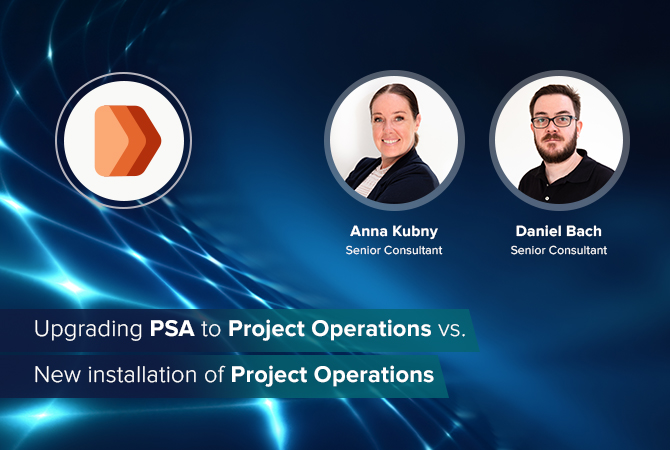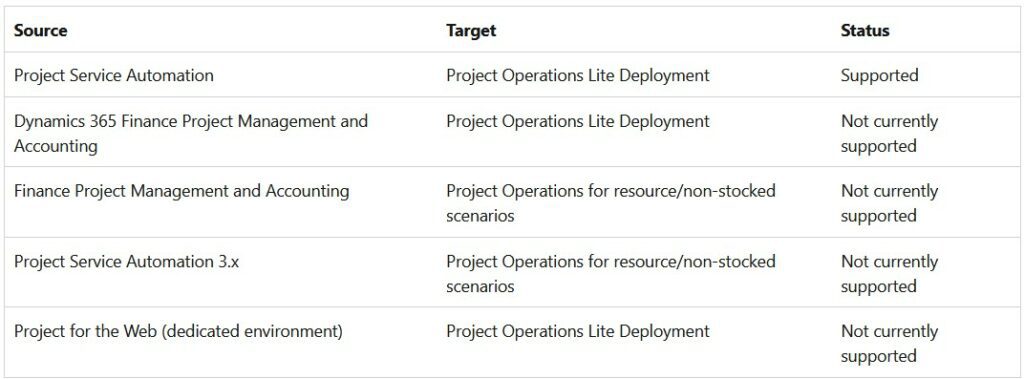
Upgrading PSA to Project Operations vs. New installation of Project Operations
It is time for many companies using Microsoft Dynamics 365 Project Service Automation (PSA) to decide on the best approach for transitioning to Project Operations (PO).
You might be weighing up between the following options:
- Upgrading Project Service Automation (PSA) to Project Operations (PO)
- Installing Project Operations (PO) from scratch with data migration from Project Service Automation (PSA)
The first decision you need to make is whether you plan to use any Project Operations integration features regarding Finance & Operations within PO, or whether you want to keep working with the invoicing as you know it from PSA.
If you plan to keep working with the known invoicing from PSA, we recommend upgrading from PSA to PO with the “Project Operations Lite Deployment”.
However, should you plan using PO integration features regarding Finance & Operations, please be aware that in this case you need to set-up PO from scratch incl. data migration as the upgrade path from PSA to PO is not supported yet for Finance features.
Supported deployment types for the upgrade

In this article we focus on the Project Operations Lite Deployment vs. installing PO from scratch incl. data migration to support you making your decision.
Generally, the Project Operations Lite deployment includes the following capabilities (Microsoft):
- sales process for projects that extends Dynamics 365 Sales application experiences
- project planning using Microsoft Project for the Web
- multi-dimensional pricing
- unified resource management
- time tracking
- basic expense
- material usage
- project budgeting and time-phased forecasting
- subcontracting
- proforma invoicing for project manager’s review and edits
Microsoft Dynamics 365 Project Service Automation (PSA) is a comprehensive solution built on Dynamics 365 that helps organizations efficiently manage and deliver projects. Project Operations is the next-generation solution that builds upon the capabilities of PSA. It includes the Project for the web with cost management capabilities known from Customer Engagement.
Below are some reasons why upgrading from PSA to PO is much more advantageous compared to installing PO from scratch and migrating data:
- Seamless transition
Upgrading from PSA to PO with the Project Operations Lite Deployment ensures a smooth transition for your organization. Since PO builds upon PSA, the transition process is straightforward as existing configurations, integrations and data can mostly be leveraged without significant rework.
Implementing a new PO system and migrating data can in comparison to the above, disrupt ongoing business operations or other used Modules like Customer Service.
- Preservation of customizations and configurations
Organizations often customize PSA to fit their individual project management workflows and business processes.
Upgrading from PSA to PO allows you to preserve all customizations and configurations, reducing the need to rebuild them from scratch (which you would have to do when newly setting up PO). Depending on the customizations made, you might have to slightly update these, as PO exchanges e.g., some PSA fields/functions to new fields/functions. But a complete re-build is not needed.
As mentioned above PO exchanges quite some fields in comparison to PSA. The advantage of the PO upgrade is, that the data will automatically be moved from the deprecated fields to the new fields with the PO upgrade.
Setting up PO from scratch generally leads to having to rebuild all custom functions starting from zero.
- Data migration
When upgrading from PSA to PO you do not need to worry about data migration. All data, such as project related data or even your core data like accounts or activities stay as they are with Project Operations.
In comparison to this, establishing Project Operations from scratch and migrating data requires a significant investment of time and resources. This includes designing workflows, configuring software, defining roles and permissions, and conducting data migration tasks. It may take weeks or even months to complete the process thoroughly.
Migrating data from a PSA system involves extracting, transforming, and loading large volumes of data. This process can be complex, especially when dealing with diverse data types and structures. Ensuring the accuracy and integrity of migrated data is crucial to avoid errors and discrepancies that could impact business operations.
Data migration carries inherent risks, including the potential for data loss or corruption. If not executed carefully, valuable project information may be lost or become unusable, leading to operational disruptions and financial losses.
Looking at the data migration you would have to do when setting up PO from scratch you should be aware that you would not only have to migrate project relevant data, but also all of your core data (e. g. customer contacts, activities, companies etc.). Running the PO upgrade, the core data does not have to be touched as it simply remains in the system.
- Cost and time savings
Installing PO from scratch and migrating data is usually an extremely time-consuming and resource-intensive process. As PO exchanges many fields/functions in comparison to PSA, data migration would not be as smooth as you might expect.
Therefore, upgrading from PSA to PO is more cost-effective and efficient, as it reduces the need for extensive data migration efforts.
Requirements for PO upgrade
To be eligible for upgrade, you must meet the following criteria:
- Valid Project Operations licenses must be assigned to all active users.
- You must validate the upgrade process in at least one non-production environment that contains a representative dataset that is aligned with your production environment.
- Before running the upgrade, the target environment must be updated to the latest Project Service Automation available release.
- You need to make sure that your data is within the limits of Project for the Web. A data validation and clean-up should therefore be planned (find all limits here).
Overall, while installing PO from scratch and migrating data is an option, upgrading from PSA usually offers a more efficient, cost-effective, and seamless transition path for organizations already using PSA and looking to leverage the advanced capabilities of PO.
Organizations should carefully weigh these advantages against the associated disadvantages. Effective planning, resource allocation, and risk management are essential to ensure a successful transition with minimal disruptions to business operations.
proMX is here to lend a hand in safeguarding a smooth transition for you. Contact us!










